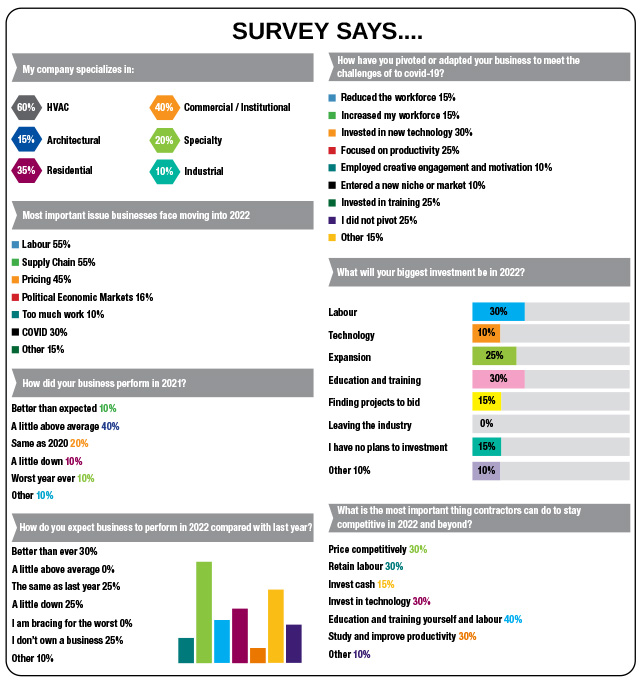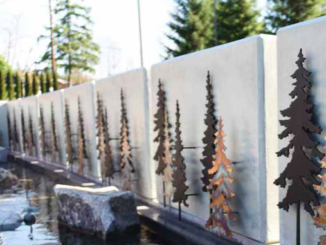
By / Jessica Kirby
In an unprecedented year, the BC sheet metal industry performed above average, stayed agile, and valued productivity over decreasing the workforce—all factors that are testament to a resilient group and a steadfast approach to adversity.
But how will that translate over time? Although nearly 70% of respondents to the 2022 Sheet Metal Industry Construction Outlook Survey said their businesses performed well above average, slightly above average, or comparable to 2020, more than half said supply chain issues and lack of skilled labour continue to challenge their operations. Nearly half also say lack of competitive pricing across the industry remains an issue, while covid-19 weighed in as the fourth most impactful influence on business in 2020.
“When you add up the cost of PPE and other measures and how they affect productivity, the costs are higher than what was immediately obvious,” said one respondent. “That was just one of the challenges—the unknown or surprise costs.”
Where covid-19 brought absenteeism, ever-changing restrictions, lower productivity, and general anxiety in 2020, last year the longer-term impacts, which included projects held back, the cost of PPE and other protective measures, and supply chain interruptions, were the main causes for concern. Contractors are expecting more of the same for 2022.
“With inflation market manipulation relating to shipping delays and other factors, covid-19, five paid days of sick time, and negotiations coming up, we see some large challenges ahead,” said one respondent. “A large concern is the the competition knowing the uprise in costs and implementing them.”
Despite anticipated challenges, as always, SMACNA contractors are prepared with strategies for fostering resilience as the current conditions remain in place for the coming year. Most of the 47% who performed better in 2021 than anticipated plan to focus on expansion and diversification in order to realize a more successful 2022.
“We are looking at productivity and what investments we need to make to help our [workforce] be more productive,” says one respondent. “We haven’t had to let anyone go; in fact, we increased our number of workers. But the only way that is sustainable is to focus on productivity and make sure we are all working smarter.”
Thirty percent of respondents have their eye on lucrative projects set to come out this year, and an equal number of respondents (30% in each category) intend to invest in labour, expansion, and education and training to help keep the business on an upward trajectory for the next 12 months.
“There are some nice projects coming down the pipeline,” says one respondent. “I know some contractors who have had great years these past few and we count ourselves as fortunate to be one of them. But it’s not by accident. We invest in our team, keep in touch with the Local, and make sure our bids are fair.”
Another interesting number was the 25% of respondents who reported they did not put any measures in place (besides government mandated protocols) to pivot or adapt to covid-19. Those who added comments to that answer said they couldn’t afford to make any additional adaptations, they were focused on maintaining the status quo, or they didn’t see a need because business was steady enough that they didn’t feel affected beyond the impacts of the standard protocols. At least three contractors identified having a good system in place prior to covid-19 was the reason they remained strong in a volatile market, and said their strategy moving forward was simply more of the same.
“Stay the course and keep numbers and quotes up,” says one contractor. “Try to foresee delays in material, and keep the communication between office and field open.”
When it came to labour, several respondents said finding labour was difficult, but also saw light at the end of the tunnel, thanks to Local 280 and the Sheet Metal Training Centre’s ability to turn out well-trained, skilled labour.
“We have a very capable and strong apprenticeship training program,” said one respondent. Moving forward is a matter of attracting prospective apprentices and investing in their training.
While the nature of construction moving into 2022 is only as clear as the most recent predictions, there remains a sense of optimism among survey respondents, even those for whom the past two years have been trying.
“We have stayed steady for the last 18 months or two years, and in any other year that would be seen as a disappointment,” said one respondent. “But considering the way things have gone, with labour shortages, interruptions in the supply chain, and, of course, the pandemic, we are counting our blessings and see staying steady as a win and a reason to stay positive about whatever happens next.” ■




